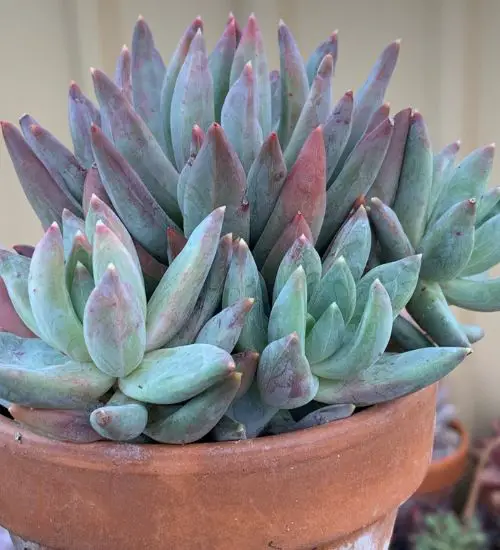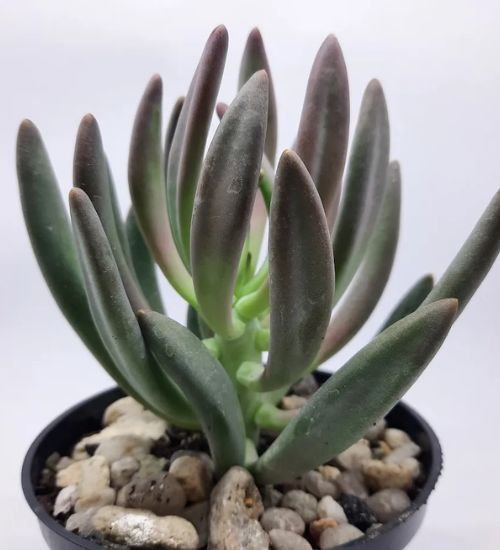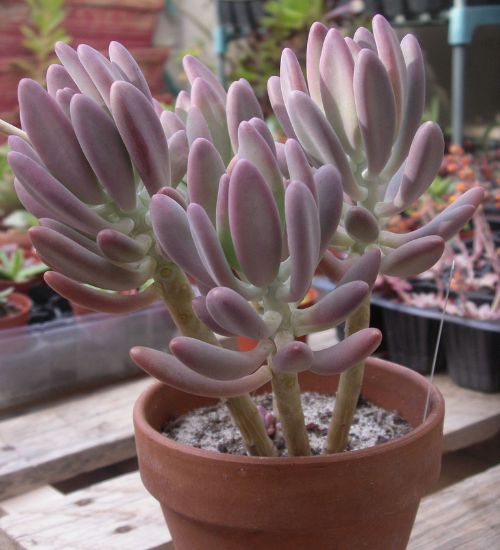Sun: full sun to partial shade
Water: Typical water needs for a succulent
Temperature: Zone 9a from 20° F to 25° F (-6.7 ° C to -3.9° C) to Zone 12b from 55° F to 60° F (12.8° C to 15.6° C)
Winter Survival: Not cold hardy
Propagation: leaves, offsets, stem cuttings
Flower: In the Spring
Flower Type: pink
Toxic: Generally non-toxic to humans and animals
Dormant: winter
Space Requirement: Indoors & Outdoors
Common Problems: Plants may rot if overwatered
Where to buy Pachyphytum Longifolium?
Basc Care for Pachyphytum Longifolium
Watering
You can water your succulent more than often in extreme conditions but make sure that the soil is completely dry before watering your succulent again.
One simple tip for you is that you can use some online apps to check the soil status before you go water your succulents. I would recommend the ThePlantsCheck app, it has some nice features there.
Fertilizing
Only feed this succulent during its active growing seasons which means winter. Use the right fertilizer applied in the right amounts. Applying half-strength balanced fertilizer every month or so is recommended for optimal results.
Do not fertilize during winter as the plant is dormant.
Sun & Location Requirements for "Pachyphytum Longifolium"
Pachyphytum Longifolium requires full sun to partial shade. It's best to keep it in an area of your garden or home that gets plenty of bright, indirect sunlight throughout the day. When temperatures are too hot and direct sunlight is too intense, try moving Pachyphytum Longifolium to a shadier spot for part of the day.
As per this succulent profile, it is only able to stay healthy when the environment temperature is above the range of zone 9a from 20° F to 25° F (-6.7 ° C to -3.9° C).
In order to ensure that Pachyphytum Longifolium survives the winter, insulation and drainage are essential. A layer of mulch or gravel around the plant can help keep the roots warm during cold temperatures. Furthermore, avoiding exposure to wind and sun can reduce the risk of frost damage and promote longevity for your succulent.
Any succulents in the group will need a medium space to grow. You can place your pot at your table or window. Since this plant needs more space than mini succulents, you should consider do not plant them together with other succulents/plants.
Pachyphytum Longifolium also benefits from some indirect light throughout the day as well, so make sure you give it enough space to soak up light without becoming too exposed to heat.
Propagation
Propagating succulents with leaves is a satisfying way to obtain new plants. Start by cutting some healthy leaves from the mother plant, then place them on top of potting mix and water regularly. In time you'll have vibrant succulents that you grew yourself!
Offsets are an easy and reliable way to propagate succulents, like Pachyphytum Longifolium. With just a few simple steps, you can get a brand-new plant from an existing one.
Propagating Pachyphytum Longifolium by stem cuttings is an easy and fun way to increase your collection of these unique houseplants. When propagating, it’s important to choose healthy stems from existing plants that are at least two inches long and have several leaves attached.
Toxicity

Pachyphytum Longifolium is generally non-toxic to humans and animals. However, the plant may contain certain toxins which can cause mild skin irritation if it is ingested or comes in contact with skin. Therefore, it is important to keep the plant away from children and pets for safety reasons.


